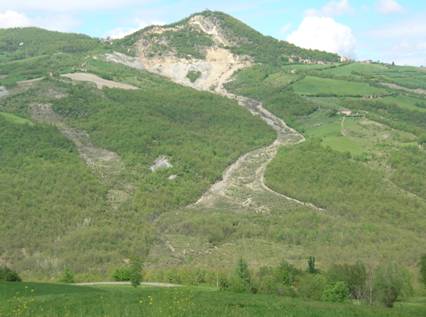By Alessandro Pasuto1, Mauro Soldati2, & Doriano Castaldini
21 CNR – IRPI Padova (Italy)
2 Dipartimento di Scienze della Terra, Università di Modena e Reggio Emilia (Italy)
When a study of mass movements is enterprised, which also aims to define landslide hazard, it is of paramount importance to use clear terminology which can be universally understood also by non-specialists (IAEG, 1990). It is therefore important for these phenomena to be immediately identified and subdivided according to the characteristics directly observable. In scientific literature, there are several “classifications” regarding to slope movements which have been proposed since the beginning of the 20th century. These often complied with the needs of various authors but more recently an effort has been made to use the least ambiguous terminology.
Most recent classifications try to emphasize both the processes leading to the development of a landslide and the materials involved; others are based on morphology, landslide mechanism, deformation velocity, causes of movement, geometry of the failure area and the deposits, age, etc. This section does not aim to describe the numerous “classifications” proposed but particular attention will be given to the most commonly accepted, that is illustrated and subsequently modified by Varnes (Varnes, 1978; Cruden & Varnes, 1996) Varnes proposed his first subdivision in 1958; subsequent elaborations were carried out in 1978 and 1996 and at the moment this subdivision is universally accepted.
The main criterion used by the author in the identification of the landslide categories is the type of movement, whereas a further subdivision is made on the basis of the type of material. As for the type of movement, five categories are represented: falls, topples, slides, spreads and flows. On the other hand, the materials are divided into two types: rock and engineering soil; the latter is further subdivided into debris and earth. In this way a landslide can be described by means of two words: the first one describing the material and the second one the type of movement (Table 1).

Complex: is the result of the combination of two or more of the five classes above illustrated. In the Cruden & Varnes (1996) classification the term «complex» has been retained as a description of the style of activity of a landslide. Moreover, other attributes are introduced so that the definition becomes more elaborate but more information is thus available on the gravitational movement. The type of landslide is described by a series of adjectives placed in sequence which provide information about the activity, the rate of movement, the moisture content, the material and type of movement (e.g. active rapid wet rock slide).

For the references herein and for knowing sources of didactic material go to 1.3 Selected references.